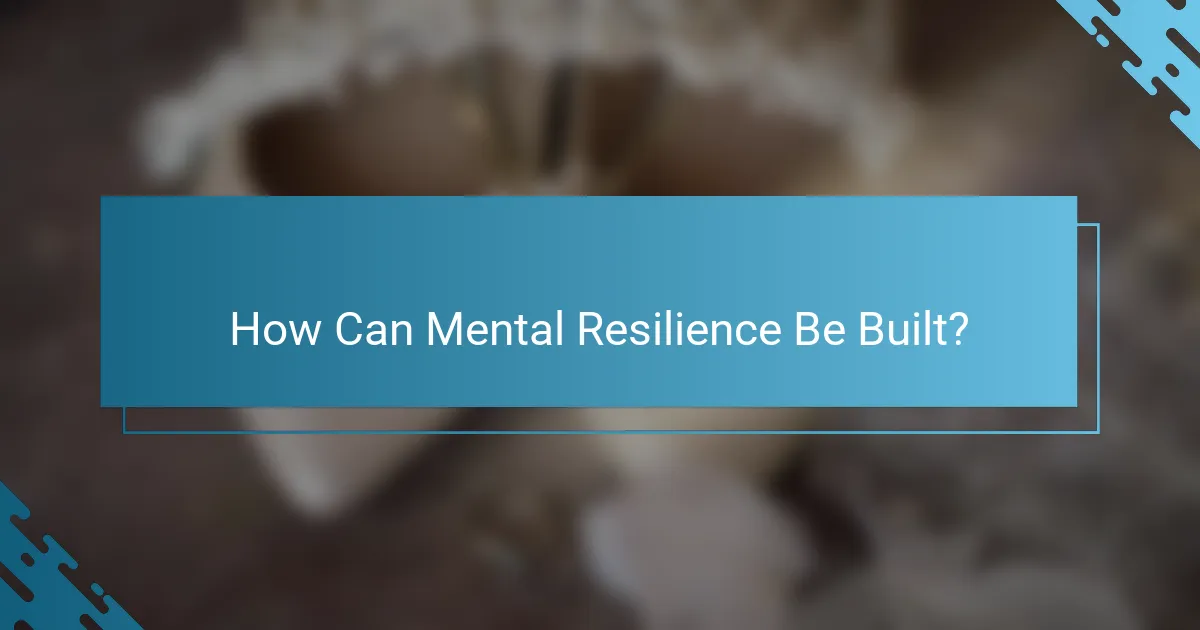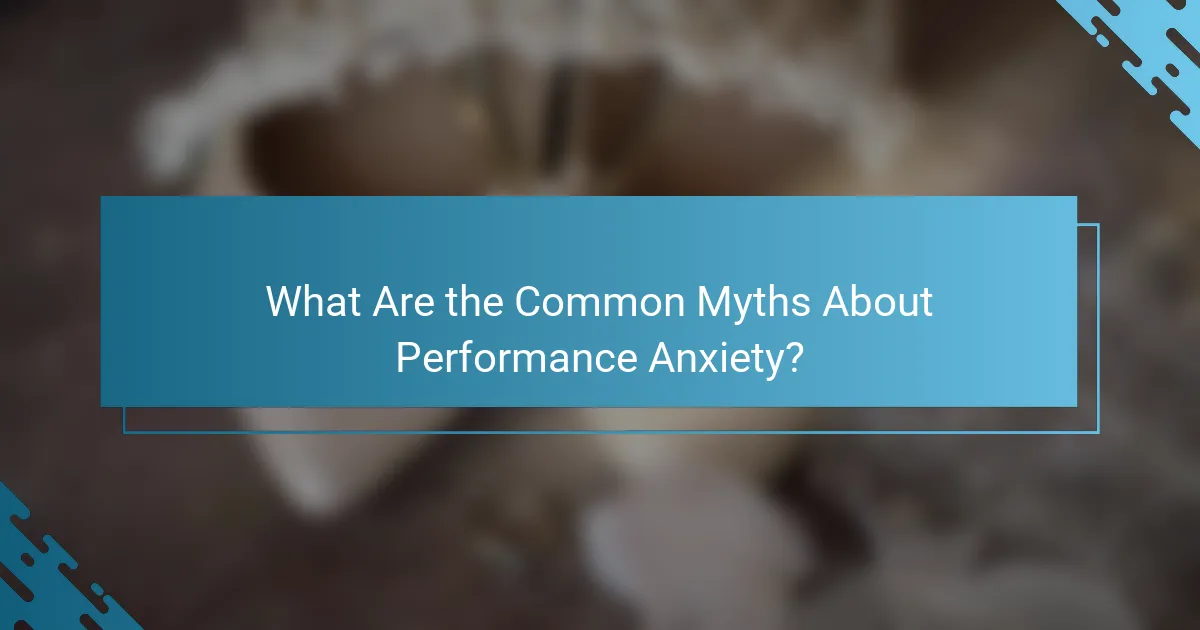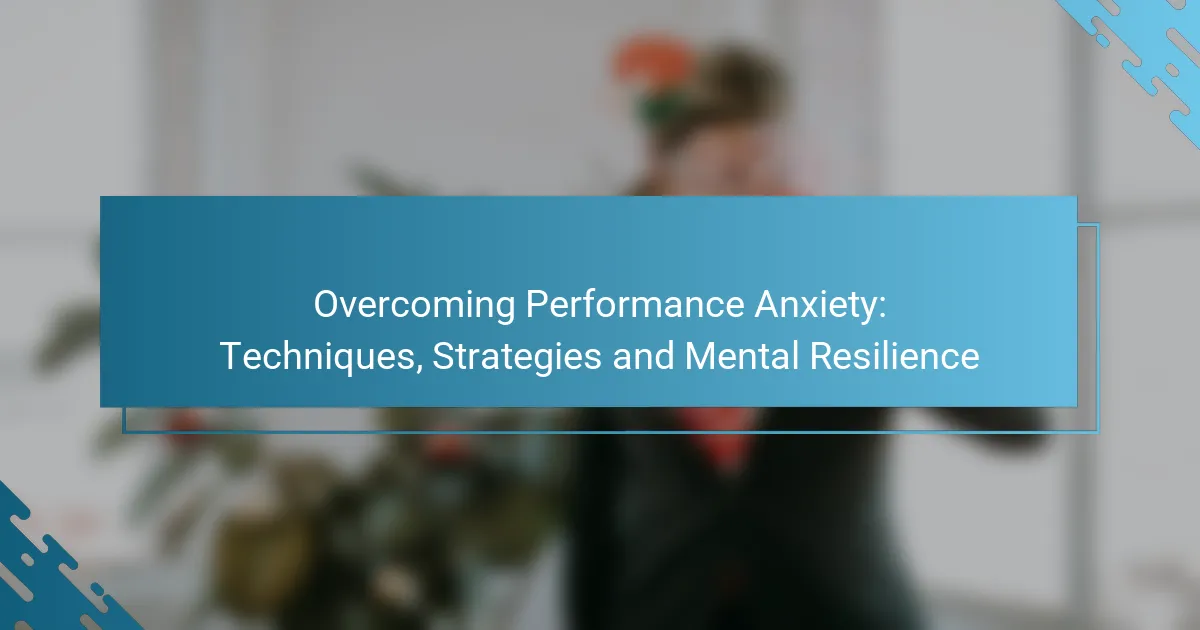Performance anxiety can be a significant barrier to achieving one’s potential, but several effective techniques can help individuals manage and overcome these feelings. By focusing on calming the mind and body, enhancing mental resilience, and shifting negative thought patterns, individuals can build confidence and reduce uncertainty. Intentional practices such as goal setting and fostering a growth mindset are essential in developing the skills needed to cope with stress and challenges.

What Techniques Help Overcome Performance Anxiety?
Several techniques can effectively help individuals manage and overcome performance anxiety. These methods focus on calming the mind and body, enhancing mental resilience, and shifting negative thought patterns.
Breathing exercises
Breathing exercises are a fundamental technique for reducing performance anxiety. They involve focusing on slow, deep breaths to promote relaxation and lower heart rates. A common method is the 4-7-8 technique, where you inhale for four seconds, hold for seven seconds, and exhale for eight seconds.
Practicing these exercises for just a few minutes before a performance can significantly decrease anxiety levels. Aim to incorporate them into your daily routine to build a habit of calmness.
Visualization techniques
Visualization techniques involve mentally rehearsing a successful performance to build confidence and reduce anxiety. This practice can include imagining the environment, the audience, and the positive feelings associated with success. Spend a few minutes each day picturing yourself performing flawlessly.
To enhance effectiveness, use all your senses in the visualization process. The more vivid and detailed the imagery, the more impactful it can be in preparing your mind for the actual event.
Mindfulness meditation
Mindfulness meditation helps individuals focus on the present moment, reducing anxiety about future performance. This practice encourages awareness of thoughts and feelings without judgment, fostering a sense of calm. Start with just a few minutes each day, gradually increasing the duration as you become more comfortable.
Consider using guided meditation apps or online resources to help you get started. Regular practice can lead to improved emotional regulation and resilience over time.
Cognitive restructuring
Cognitive restructuring involves identifying and challenging negative thought patterns that contribute to performance anxiety. By replacing these thoughts with more positive and realistic ones, individuals can change their emotional responses. Start by writing down anxious thoughts and questioning their validity.
For example, instead of thinking, “I will fail,” reframe it to, “I have prepared well and can handle this.” This shift can help reduce anxiety and enhance confidence during performances.
Progressive muscle relaxation
Progressive muscle relaxation (PMR) is a technique that involves tensing and then relaxing different muscle groups to alleviate physical tension associated with anxiety. Begin by focusing on one area of the body, such as your hands, and tense the muscles for a few seconds before releasing. This process can be repeated for various muscle groups.
Practicing PMR regularly can help you become more aware of physical tension and learn to release it effectively, making it a valuable tool for managing performance anxiety before events.

How Can Mental Resilience Be Built?
Mental resilience can be built through intentional practices that strengthen your ability to cope with stress and challenges. This involves developing skills such as goal setting, fostering a growth mindset, practicing self-compassion, and creating a supportive network.
Setting realistic goals
Setting realistic goals is crucial for building mental resilience. Start by defining specific, measurable, achievable, relevant, and time-bound (SMART) objectives that align with your capabilities and circumstances. This approach helps prevent feelings of overwhelm and fosters a sense of accomplishment.
Break larger goals into smaller, manageable tasks. For instance, if your aim is to improve public speaking, you might start by practicing in front of a mirror, then progress to speaking in front of friends before addressing larger groups.
Developing a growth mindset
A growth mindset is the belief that abilities can be developed through dedication and hard work. Embracing this perspective encourages resilience by viewing challenges as opportunities for growth rather than obstacles. To cultivate this mindset, focus on learning from failures and celebrating progress.
Engage in self-reflection to identify areas for improvement and seek feedback from others. This can help you adapt your strategies and reinforce the idea that effort leads to mastery over time.
Practicing self-compassion
Practicing self-compassion involves treating yourself with kindness during difficult times. Instead of harsh self-criticism, acknowledge your struggles and remind yourself that everyone faces challenges. This approach fosters emotional resilience and reduces anxiety.
Incorporate self-care routines that promote well-being, such as mindfulness meditation or journaling. These practices can help you develop a more compassionate inner dialogue and enhance your overall mental health.
Building a support network
A strong support network is essential for mental resilience. Surround yourself with individuals who uplift and encourage you, whether they are friends, family, or colleagues. Sharing experiences and seeking advice can provide valuable perspectives and emotional support during tough times.
Consider joining groups or communities that align with your interests or challenges. Engaging with others facing similar situations can foster a sense of belonging and reinforce your resilience as you navigate life’s ups and downs.

What Role Does Preparation Play?
Preparation is crucial in overcoming performance anxiety as it builds confidence and reduces uncertainty. By thoroughly preparing, individuals can familiarize themselves with the performance environment and anticipate challenges, leading to improved mental resilience.
Rehearsing performance scenarios
Rehearsing performance scenarios allows individuals to simulate the actual performance conditions, which can significantly reduce anxiety. This practice can include role-playing, visualizing success, or even performing in front of a small audience to build comfort and familiarity.
Consider setting aside time each week to practice specific scenarios. Aim for at least two to three rehearsals leading up to the performance, adjusting based on comfort levels and feedback received.
Gathering feedback
Gathering feedback from trusted peers or mentors can provide valuable insights into areas of improvement and strengths. Constructive criticism helps individuals refine their skills and boosts confidence by highlighting progress.
After each rehearsal, seek feedback on specific aspects, such as delivery, body language, or content clarity. Aim to incorporate at least one actionable piece of feedback into subsequent practices to enhance performance quality.
Creating a performance checklist
A performance checklist serves as a practical tool to ensure all necessary preparations are completed before the event. This list can include items such as equipment checks, rehearsal schedules, and mental preparation techniques.
Develop a checklist tailored to your specific performance needs. Review it regularly and update it based on experiences from past performances to ensure it remains relevant and effective. Aim to finalize your checklist at least a few days before the performance to allow time for any last-minute adjustments.

How Can Professional Help Assist?
Professional help can significantly aid individuals in overcoming performance anxiety by providing tailored strategies and support. Therapists and coaches can offer techniques to manage anxiety, build confidence, and improve overall performance in various settings.
Cognitive-behavioral therapy (CBT)
Cognitive-behavioral therapy (CBT) is a structured approach that helps individuals identify and challenge negative thought patterns associated with performance anxiety. Through CBT, clients learn to reframe their thinking, which can reduce feelings of fear and self-doubt.
Typically, CBT involves weekly sessions over a period of several months, focusing on practical exercises and real-life applications. Techniques may include exposure therapy, where individuals gradually face their fears in a controlled environment, helping them build resilience.
Performance coaching
Performance coaching focuses on enhancing skills and confidence in specific areas, such as public speaking or sports. Coaches work with clients to set achievable goals, develop action plans, and practice techniques that can alleviate anxiety during high-pressure situations.
Coaching sessions often include role-playing and visualization exercises, which can help individuals mentally prepare for performances. Regular feedback and encouragement from a coach can also foster a growth mindset, making it easier to handle anxiety when it arises.
Group therapy sessions
Group therapy sessions provide a supportive environment where individuals can share their experiences and learn from others facing similar challenges. This collective approach can normalize feelings of anxiety and reduce isolation, making it easier to cope with performance-related stress.
During these sessions, participants engage in discussions, role-playing, and skill-building activities. The shared experiences can lead to valuable insights and strategies that individuals can apply in their own lives, enhancing their ability to manage performance anxiety effectively.

What Are the Common Myths About Performance Anxiety?
Performance anxiety is often misunderstood, leading to several myths that can hinder effective coping strategies. Recognizing these myths is crucial for developing a healthier mindset and overcoming anxiety in performance situations.
Myth 1: Only Weak People Experience Performance Anxiety
One common myth is that only individuals lacking confidence or strength experience performance anxiety. In reality, many high-achieving individuals, including athletes and performers, face this challenge. It is a normal human response to pressure, regardless of one’s overall capabilities.
Understanding that performance anxiety can affect anyone helps to normalize the experience. This awareness can reduce feelings of isolation and encourage individuals to seek support and strategies to manage their anxiety.
Myth 2: Performance Anxiety Means You Are Not Prepared
Another misconception is that experiencing performance anxiety indicates a lack of preparation. However, even the most prepared individuals can feel anxious before a performance. This anxiety often stems from the desire to succeed and the fear of disappointing oneself or others.
Preparation is important, but it does not eliminate anxiety. Recognizing that anxiety can coexist with thorough preparation allows individuals to focus on managing their feelings rather than questioning their readiness.
Myth 3: Performance Anxiety Will Go Away on Its Own
Many believe that performance anxiety will diminish without intervention. While some may experience a reduction over time, relying solely on this hope can lead to missed opportunities for growth. Proactive strategies are often necessary to effectively manage anxiety.
Engaging in techniques such as visualization, breathing exercises, and gradual exposure can significantly help. These methods empower individuals to take control of their anxiety rather than waiting for it to fade away.
Myth 4: You Should Avoid Performance Situations to Overcome Anxiety
Some think that avoiding performance situations will help them overcome anxiety. In truth, avoidance can reinforce anxiety and make it worse over time. Facing performance situations, even in small doses, can build resilience and confidence.
Gradual exposure to performance settings allows individuals to practice coping strategies in real-time. This approach can lead to desensitization and a greater sense of control over anxiety in future situations.
